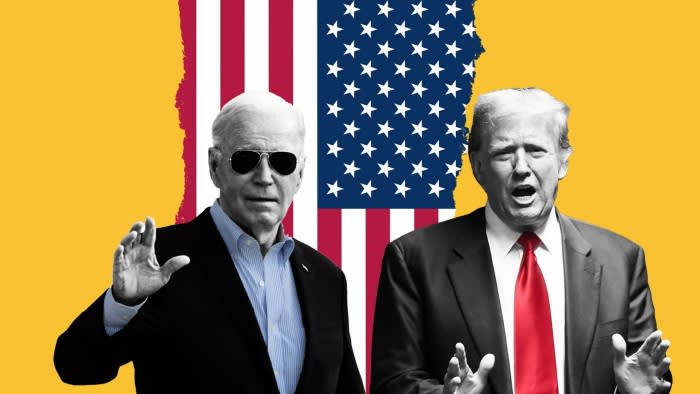Unlock the Editor’s Digest for free
Roula Khalaf, Editor of the FT, selects her favourite stories in this weekly newsletter.
Stock traders have begun placing bets on an upsurge of volatility around November’s US election, which is shaping up to feature a tense rematch between President Joe Biden and his predecessor Donald Trump.
Futures contracts tied to the value of the Vix index — the so-called “fear gauge” that measures expectations of near-term swings in the S&P 500 equities benchmark — are pricing in a rise in market stress in the weeks before and after voters head to the polls.
Past elections have sparked market gyrations, giving investors reason to bet or hedge around them. Trump’s surprise victory over Hillary Clinton in November 2016 led to a fleeting drop in S&P 500 futures before stocks proceeded to stage gains.
But “this year traders have started pricing out the election Vix bump way earlier than they have in the past”, said Mandy Xu, head of derivatives market intelligence at exchange operator Cboe Global Markets, which produces the volatility index. Typically, “the two to three months prior is maybe when you start to see it,” she added.

Investors are unable to trade the Vix directly. Instead, they can purchase futures contracts whose prices reflect where traders believe the Vix will be trading at different points in the months ahead.
The Vix curve shows a steady rise over the next six months from its current level of 12.8. Prices then jump above 20 for the October contracts, which are set to expire just after election day on November 5.
A similar late-year rise exists in prices for the VStoxx index, which tracks Europe’s Euro Stoxx 50. Market expectations for higher volatility subside for contracts that expire the following month.
The market is coasting through a period of relatively low volatility. The Vix has held below its historical average of about 20 since the beginning of 2023 despite uncertainty around the path of inflation and interest rates. VStoxx this month fell to its lowest level in five years.

The shape of the Vix futures curve stands in contrast to four years ago, when the spread of coronavirus drove immediate volatility far above expectations for November 2020, when Biden beat Trump in a defeat the former president refused to acknowledge. In early 2016, Vix futures showed no jump in expected market volatility around the coming election.
Recent polls suggest Biden and Trump are neck and neck, and because investors generally loathe uncertainty, UBS analysts last week wrote they “wouldn’t be surprised to see some pick up in equity market volatility” as the election draws closer.
HSBC equity strategists Nicole Inui and Alastair Pinder echoed those forecasts in a note to clients on Monday, writing that they expect the election to contribute to “a more volatile” second half of the year.
Subdued volatility is not unusual when equity markets are rallying, as they have been in Europe and the US since late October. Goldman Sachs, Bank of America and Société Générale have all recently raised their end of year forecasts for the S&P, which has notched more than a dozen record closes in 2024.
Yet some analysts have recently suggested the growth of equity exchange traded funds that incorporate options into their strategies may be artificially compressing the Vix.
Dealers of these sorts of products are driven to buy stocks when the market is falling and sell when they are rising. By doing so, dealers are “effectively dampening the price movements” of the S&P, according to a March report from the Bank for International Settlements.
“The meteoric rise of yield-enhancing structured products linked to the S&P 500 over the last two years has gone hand in hand with the drop of [the] Vix over the same period,” the report added.
